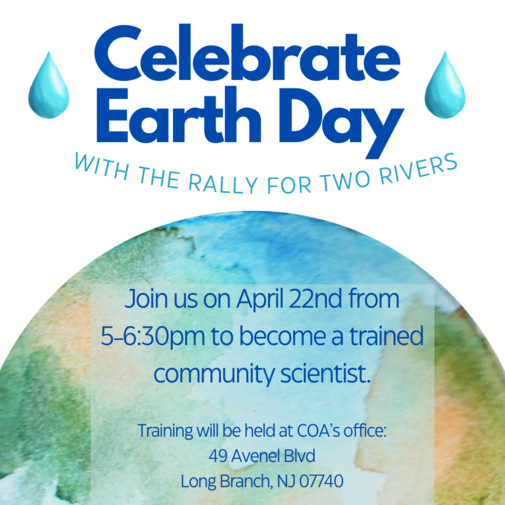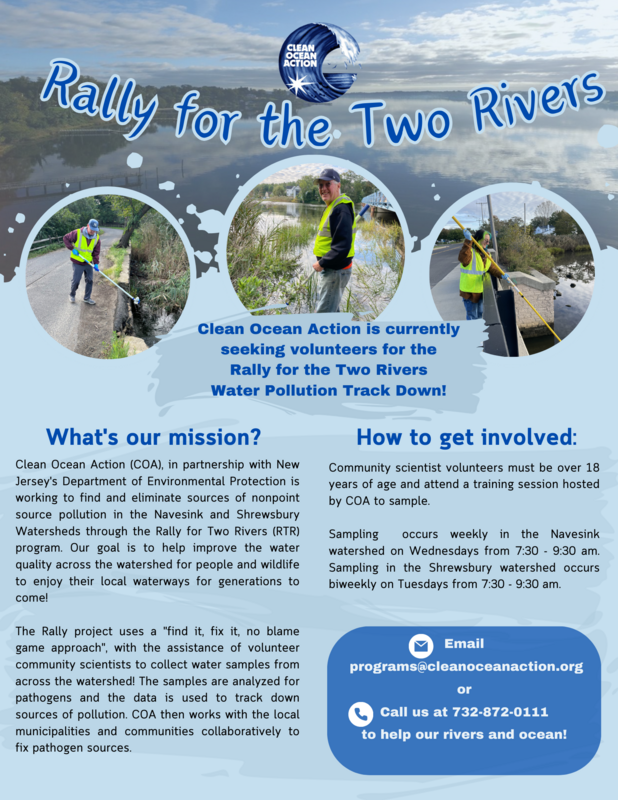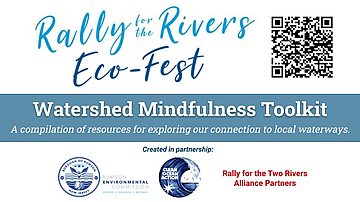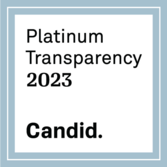What is Rally for the Two Rivers?
The Rally for Two Rivers (RTR) is an ongoing water quality monitoring program focused on tracking down pathogen pollution sources throughout the Navesink and Shrewsbury River watersheds. Pathogen pollution refers to contamination of a waterway by microorganisms such as bacteria, viruses, protozoa etc. These microorganisms can cause harmful diseases to humans and animals in addition to impacting water quality. The RTR program is a continuation of the successful Rally for the Navesink Ambient Bacteria Monitoring Program which was launched in 2017 in partnership with NJ Department of Environmental Protection (NJDEP).
Project Background
Clean Ocean Action (COA) established the Rally for the Navesink coalition in 2016 to address the chronic pathogen pollution and the 2015 downgrade of 500+ acres of shellfish harvesting areas in the Navesink River to a prohibited harvest classification by NJDEP. The Rally model is a strategic “no-blame”, collaborative, track down approach with a specific goal – to find, fix, and eliminate sources of pathogen pollution.
Historically, the Navesink River has been home to a variety of rich marine life including fish, shellfish, and waterfowl. More importantly, with 2,520 acres of shellfish harvesting areas, it is the only remaining direct shellfish harvesting area in the New York – New Jersey estuary. However, in recent decades, areas that were once thriving shellfish beds have suffered from the effects of pathogen pollution impacting these waterways. Stormwater runoff and wet-weather events exacerbate the spread of pathogen pollutants through transport from land to water.

Common sources of pathogen pollution:
(i) human fecal pollution from leaky/damaged sanitary sewer infrastructure, improperly managed/failing septic systems, and illicit connections
(ii) improper disposal of pet waste from dogs and cats
(iii) domestic waste run off from livestock such as horses, cattle, etc.
(iv) Fecal pollution from local wildlife (ie. Birds)
Click here to view NJDEP's National Shellfish Sanitation Program (NSSP) classification map for Shellfish Harvesting.
As a first step of the program, COA published an in-depth report detailing the history of pathogen pollution in the Navesink watershed (COA, 2016) and highlighted key concerns and recommendations. These included (i) monitoring and investigating potential pathogen sources upstream of the river (ii) monitoring for fecal indicator bacteria under ambient conditions and wet-weather conditions and (iii) collaboratively utilizing the data to determine and remove sources.
Subsequently, the Rally for the Navesink collaborated with local municipalities and NJDEP to conduct an innovative source track down study in 2016 using scent-trained canines and analytical laboratory verification to monitor and track down sources of bacteria pollution in the watershed. These canine screening investigations were conducted to identify likely human sources of fecal pollution. The findings were then used to launch the COA-DEP collaborative ambient weekly bacteria monitoring program in the summer of 2017.
The program depended on the help of community scientists to collect water samples and adhered to the requirements of an NJDEP-approved Quality Assurance Project Plan (QAPP, 2017). All RTR community scientists were trained by COA and NJDEP, and collected more than 3,000 samples for three years. The collected samples were analyzed in NJDEP’s Leeds Point Laboratory until the program was put on hold due to the Covid pandemic in 2020.
The results helped to identify likely upstream pollution sources and enabled municipalities to implement targeted efforts to eliminate these sources. The Rally also focused on continuing public engagement, outreach, and watershed mindfulness through supplemental education curriculum for K-12 students. Since then, multiple areas of the Navesink have seen an improvement in water quality, and some areas are close to being upgraded.
Due to the success of the Rally for the Navesink project and an ongoing need to continue monitoring pathogen pollution within the watershed, the expanded Rally for the Two Rivers Ambient Bacteria Monitoring Program was relaunched in the summer of 2023 to monitor the Navesink and Shrewsbury River watersheds. All samples collected from the Shrewsbury watershed are being analyzed at COA’s in-house Water Quality laboratory.

Sampling Schedule
Navesink River sampling is ongoing weekly, every Wednesday from 7:30am to 9:30am.
Shrewsbury sampling occurs bi-weekly with sampling every other Tuesday from 7:30am-9:30am.
If you are from the area, we are actively recruiting volunteers to join our team of community scientists for Rally for the Two Rivers!
How to get involved
If interested in volunteering for the Rally for Two Rivers program, please complete the Community Science Volunteer Form here.
For any questions or further information, please contact programs@CleanOceanAction.org
Visit the Rally For the Two Rivers Facebook page for important updates and events.
For more information, please visit the Rally for the Two Rivers Google Drive Folder.
Celebrate Earth Day by becoming a trained community scientist for the Rally for Two Rivers on April 22nd!

Register to attend the training here!
Click here to access the Two Rivers Watershed Water Quality Reporting Form
Community members can use this resource to report water quality observations within the Navesink and Shrewsbury Rivers to Clean Ocean Action. Responses will provide critical information on what is happening in our waterways and fill information gaps for our ongoing water quality monitoring programs. Potential observations can include fish kills, algae blooms, debris in the water, or anything that seems out of the ordinary. Thank you in advance for your time and commitment to the health of our waterways!
Please note: This form is for informational purposes only. For immediate action, please contact the NJDEP via 1-877-WARNDEP (1-877-927-6337) or the WARN NJDEP app.
Looking to volunteer? Check out our flyer below for more details!


Click here to explore the Rally for the Two Rivers Waterway Mindfulness Toolkit!
Presented by Clean Ocean Action, with contributions from Rally for the Two Rivers Alliance partners, this toolkit is a compilation of educational resources that will help to instill "waterway mindfulness" in residents of all ages throughout the Two Rivers watershed. With lesson plans, hands-on activities, and other virtual learning resources, this toolkit is perfect for teachers, parents, students and anyone interested to explore!
Spring 2021 Fish Die-off in Two Rivers Area, Monmouth County
After extensive investigation in Spring 2021, the NJDEP identified the cause of dead bunker in the Two Rivers Area in Monmouth County, NJ, to be a bacterium, Vibrio anguillarum. NJDEP released an FAQ sheet with more detailed information. Read the NJDEP's FAQs here. Learn more about the die-off on COA's blog.
At May's COA Rally for the Two Rivers meeting, representatives from the NJ Department of Environmental Protection (NJDEP), alongside Senator Vin Gopal, Oceanport Mayor Jay Coffey and Councilwoman Meghan Walker, spoke about the ongoing fish die-off in the Navesink and Shrewsbury Rivers. View the Rally for the Two Rivers meeting recording.
See dead fish in local waterways or on beaches? Late August/Early September Brings More Reported Dead Fish
Report your observations and photos of the scene to the NJDEP Hotline at 1-877-927-6337, and to Clean Ocean Action at info@cleanoceanaction.org.
Clean Ocean Action is following-up with NJ Department of Environmental Protection (NJDEP) regarding recent observations of dead fish on beaches in the Raritan Bay and Toms River area as well as Wildwood Crest. Dead fish on the beaches of Wildwood Crest were reported by Scott Fallon at The Bergen Record on September 1. Thanks to NBC's Brian Thompson for alerting Clean Ocean Action to this report!
Earlier in the week of August 30, 2021, Clean Ocean Action observed similar dead fish in the Toms River area during our water quality field visits. Visual observations suggested that those in the Toms River are Atlantic Menhaden and exhibited symptoms similar to the dead fish observed during the massive die-off in the Two Rivers area in Monmouth County in Spring 2021 (that die-off was caused by Vibrio anguilarum bacterial infection). Clean Ocean Action is in communitcation with NJDEP officials who are working to determine if these recent incidents are related to vibrio-infected die-offs or attributed to any other causes.


